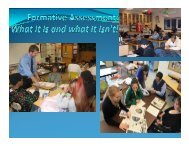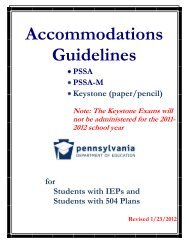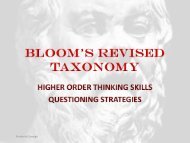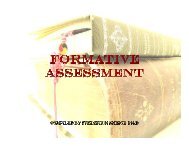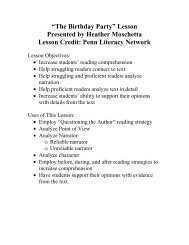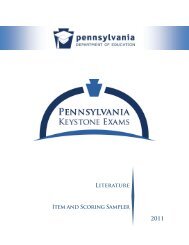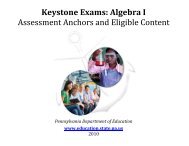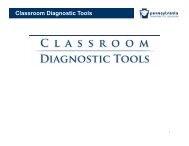FORMATIVE ASSESSMENT (Assessment for learning)
FORMATIVE ASSESSMENT (Assessment for learning)
FORMATIVE ASSESSMENT (Assessment for learning)
You also want an ePaper? Increase the reach of your titles
YUMPU automatically turns print PDFs into web optimized ePapers that Google loves.
There is a record<br />
Is a more deliberate<br />
response because it is<br />
not spontaneous<br />
Some students prefer<br />
written responses<br />
DISADVANTAGES<br />
Handwriting must be<br />
legible.<br />
Takes more time.<br />
Students may not<br />
understand the<br />
feedback.<br />
Hawk and Hill (2001)<br />
dialogue between<br />
student and teacher.<br />
Some students prefer<br />
oral feedback<br />
Easy to <strong>for</strong>get<br />
No record of feedback<br />
Students may not<br />
understand the<br />
feedback<br />
Easy to understand<br />
Is silent so that others<br />
do not hear it<br />
Some students prefer<br />
nonverbal feedback<br />
Easy to <strong>for</strong>get<br />
No record<br />
Students may not<br />
understand the<br />
feedback<br />
May work better<br />
when requiring lower<br />
level thinking<br />
feedback<br />
Teachers and students<br />
need ready access to<br />
technology<br />
SELF and PEER <strong>ASSESSMENT</strong><br />
In addition to teacher feedback, when students and their peers are involved in the <strong>for</strong>mative<br />
assessment process there are many more opportunities to share and receive feedback.<br />
Students can play an important role in their <strong>learning</strong> through self assessment and peer<br />
assignment. Two experimental studies using experimental and control groups have provided<br />
evidence that students who understand the <strong>learning</strong> objectives and assessment criteria and have<br />
opportunities to reflect on their work, show greater improvement in <strong>learning</strong> than those students<br />
who do not (Fontana & Fernandes, 1994; Frederiksen & White, 1997<br />
Students with <strong>learning</strong> disabilities who are taught to use self-monitoring strategies related to their<br />
understanding of reading and writing tasks also show per<strong>for</strong>mance gains (McCurdy & Shapiro,<br />
1992; Sawyer, Graham, & Harris, 1992).<br />
Teachers helping students to provide constructive feedback to each other, and involving students<br />
in decisions about how to move <strong>learning</strong> <strong>for</strong>ward are illustrations of students and teachers<br />
working together in the teaching and <strong>learning</strong> process.<br />
Students can develop the competency to meta-cognate and to offer themselves feedback if<br />
properly trained in meta-cognition. Helping students to think meta-cognitively about their own<br />
FLS Page 17



